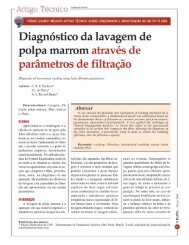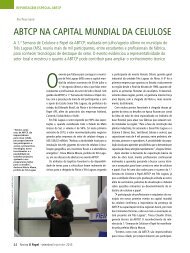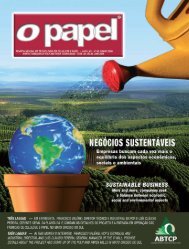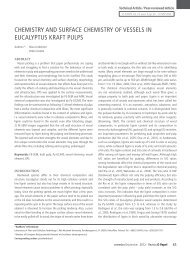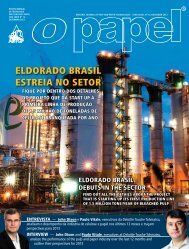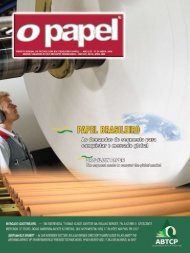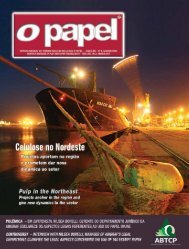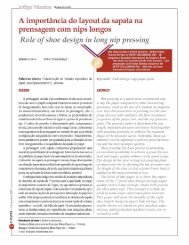international article - Revista O Papel
international article - Revista O Papel
international article - Revista O Papel
You also want an ePaper? Increase the reach of your titles
YUMPU automatically turns print PDFs into web optimized ePapers that Google loves.
o número mais alto de fibras por volume, comportar-se-á<br />
diferentemente em relação a forças de cisalhamento. O tipo<br />
suave de tratamento LCR das fibras, obtido com consistências<br />
mais altas da polpa, a que anteriormente se fazia referência<br />
como “umedecimento” ou “escovação” (Espenmiller 1969,<br />
Casey 1960, d’A. Clark 1978), descreve o desprendimento de<br />
fibrilas externas e fragmentos de fibras, o que é designado<br />
como “fibrilação externa”. Geralmente, uma consistência de<br />
refinação mais alta também reduz o encurtamento das fibras,<br />
mas cria fibras encurvadas ao invés disso.<br />
É bem conhecido o fato de que a resistência ao rasgo de<br />
folhas de polpa feitas à mão (Figura 6) é altamente dependente<br />
do índice de comprimento médio das fibras, apresentando resultados<br />
- ver Figura 5 - em boa concordância com isto. Um<br />
menor número de fibras por volume resultou em fibras mais retas<br />
e mais longas, ao passo que um tratamento com consistência da<br />
polpa de 6% resultou na geração de encurvamento das fibras -<br />
ver Figura 6. Os dados medidos da espessura da parede celular<br />
conforme Kajaani implicam que ocorreu fibrilação externa<br />
em seguida ao tratamento de cisalhamento. Era evidente que a<br />
forma do tratamento proporcionava ação de cisalhamento nas<br />
fibras, promovendo uma liberação de partes externas das fibras.<br />
Os resultados apresentados indicaram que a modalidade do<br />
tratamento das fibras aplicada na refinação da polpa, principalmente<br />
no que se refere ao comprimento e ao encurvamento<br />
das fibras, foi sensível em relação à consistência da polpa na<br />
faixa de 2%–6%, com as demais condições constantes. Foi<br />
evidente que o tratamento de refinação fornecido se alterou<br />
com a taxa de transferência de energia e a consistência da<br />
polpa: um pequeno número de fibras por volume intensificou<br />
o endireitamento das fibras devido a uma maior incidência de<br />
contatos entre barras e fibras, ao passo que cifras de consistência<br />
mais elevadas implicam mais interações entre as fibras.<br />
Encurvamento das fibras, % / Fibre curl, %<br />
18.0<br />
17.5<br />
17.0<br />
16.5<br />
16.0<br />
15.5<br />
15.0<br />
14.5<br />
2 %<br />
4 %<br />
6 %<br />
14.0<br />
4.0<br />
10 12 14 16 18 20<br />
Grau de refinação, ºSR / Beating degree, ºSR<br />
ber of fibres per volume, will behave differently to<br />
shear forces. The mild type of LCR fibre treatment<br />
achieved at higher pulp consistencies was earlier<br />
referred to as “wetting or” “brushing” (Espenmiller<br />
1969, Casey 1960, d’A. Clark 1978) and depicts the<br />
loosening of external fibrils and fibre fragments,<br />
which is denoted “external fibrillation”. Generally,<br />
a higher refining consistency also reduces fibre shortening,<br />
but creates curly fibres instead.<br />
It is well-known that the pulp handsheet tear<br />
strength (Figure 6) is strongly dependent on the<br />
average fibre length index, and the results were<br />
well in concordance, Figure 5. A lower number<br />
of fibres per volume resulted in straighter and<br />
longer fibres whereas a treatment at 6% pulp<br />
consistency resulted in creation of fibre curl,<br />
Figure 6. The measured data on the Kajaani cell<br />
wall thickness imply that an external fibrillation<br />
occurred upon the shear treatment. It was apparent<br />
that the mode of the treatment provided<br />
shearing action on fibres promoting a release of<br />
external fibre parts.<br />
The presented results indicated that the mode<br />
of the fibre treatment applied in pulp refining, especially<br />
regarding the fibre length and curl, was<br />
sensitive towards pulp consistency in the range<br />
2%–6% provided otherwise constant conditions. It<br />
was apparent that the supplied refining treatment<br />
changed with the energy transfer rate, and the pulp<br />
consistency: a small number of fibres per volume<br />
enhanced fibre straightening due to greater share<br />
of bar-fibre contacts, whereas higher consistency<br />
figures imply more fibre-fibre interactions.<br />
Figura 6. Desenvolvimento da resistência ao rasgo de folhas de polpa feitas à mão (pontos de dados cheios) e comprimento médio ponderado<br />
das fibras (pontos de dados vazios) durante os tratamentos sem carga / Figure 6. Development of the pulp handsheet tear strength (filled data<br />
points) and average length-weighted fibre length (hollow data points) during the no-load treatments<br />
8.0<br />
7.5<br />
7.0<br />
6.5<br />
6.0<br />
5.5<br />
5.0<br />
4.5<br />
Espessura da parede celular, µm<br />
Cell wall thickness, µm<br />
O PAPEL - Outubro 2009 O PAPEL vol. 70, num. 10, pp. 41 - 60 OCT 2009<br />
49



